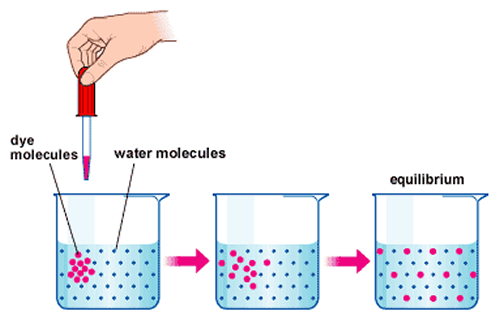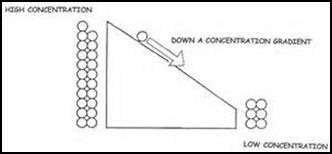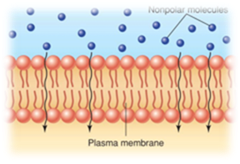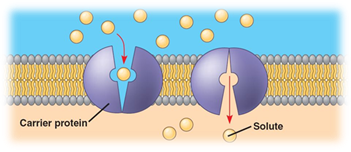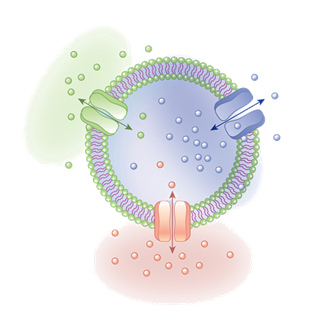
CELL TRANSPORT
In the
last unit you learned about the plasma (cell) membrane. The last unit looked at
the parts of the plasma membrane and how the plasma membrane is put together.
We already discussed how small, nonpolar substances can pass directly through
the membrane, and how other substances, which need help to pass through, make
use of membrane proteins. In this unit we will look at how the plasma membrane
allows substances to move through it in order to maintain homeostasis. The
plasma membrane is described as a Selectively
Permeable Membrane or Semi-Permeable
Membrane, because of its nature to allow some substances to pass through
but not others.
|
Active and Passive Transports |
|
|
There are two types of
transport which all movement through the membrane can be classified into:
Active Transport and Passive Transport. A couple terms you need to understand
before discussing the differences between the two transports are concentration and concentration gradient. Concentration
is the amount of a particular substance in a given volume. In other words,
how much you have of something in a certain area or space. Concentration
gradient is the difference in the concentration of a substance across a
distance or space. When speaking of gradient you will be comparing the concentrations
of two different locations. |
|
|
|
|
|
Passive Transport Introduction |
|
|
1. Increasing the concentration of the substance. Having more of the
substance will speed up diffusion. 2. Agitation. Shaking or stirring a solution will
speed up diffusion. 3. Increasing the temperature. Increasing the temperature will increase
the motion of the substance’s particles therefore speeding up diffusion. 4. Increasing the pressure. Increasing pressure will also increase the
motion or collisions of the substance’s particles therefore speeding up
diffusion. |
|
|
|
Passive Transport
|
|
|
Simple Diffusion is a type of passive transport in which small, nonpolar
molecules pass directly through the phospholipid bilayer without the help or
use of any membrane proteins. |
Facilitated
Diffusion
|
Facilitated Diffusion is also a type of passive transport. Facilitated Diffusion uses
transport proteins in the membrane to help move substances that are not small
and nonpolar through the membrane. The two types of transport proteins, as
mentioned in the last unit, are channel
and carrier proteins. |
||
|
A channel protein may be one of two types: Non-gated (pore) or
gated. A non-gated channel protein is
permanently opened and a gated channel protein opens and closes with the help
of another molecule being present to open the gate. |
||
|
Keep in mind, that
both of these membrane proteins, as well as all membrane proteins, are
dependent on shape and charge. These
proteins will only allow substances of a certain shape or certain charge to
pass through them. Not just anything can pass through any membrane protein,
the proteins are very specific in what they allow to pass through. |
||
|
|
||
|
|
Osmosis is another type of
passive transport. Osmosis is the diffusion of water across a selectively permeable membrane. Osmosis
is very important to the cell as it attempts to maintain the water balance in
the cell as the environment is always changing. Because water is a polar
molecule, the water molecules pass through channel proteins (pores) to move in
and out of the cell. When predicting the direction of water movement through a
membrane, there are three different solutions to consider.
Physical
Science Review: All solutions are made of two basic parts, a
solute and solvent. Solute is whatever is dissolved in the solution and solvent
is whatever caused the solute to dissolve.
Example: A spoonful of salt in a glass of water to make a salt water
solution. Salt is dissolved and is the solute, and the water caused the salt to
dissolve and is the solvent.
Animal
Cells (Red Blood Cell)
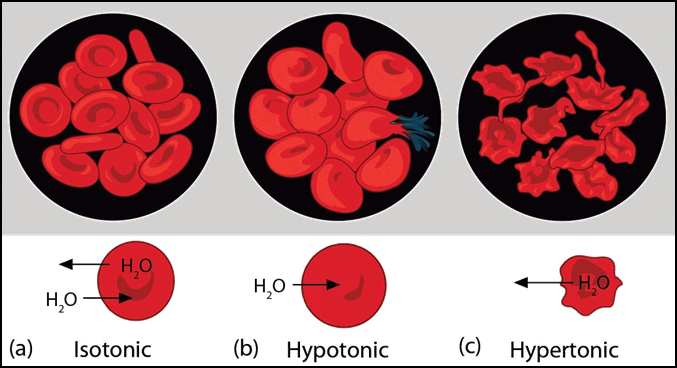
Isotonic Solution
An isotonic solution is
a solution where the solute concentration outside the cell is equal to, or the
same as, the solute concentration inside the cell, or cytoplasm. In this
situation, the water is already equal, or in equilibrium, on both
sides of the membrane (inside the cell and outside the cell). Since the water is in equilibrium, there is
no need for the water to move to either side of the membrane and the cell stays
the same size.
Hypertonic Solution
A hypertonic solution is
a solution where the solute concentration outside the cell is higher than the
solute concentration inside the cell. In this situation, since the solute
concentration is higher outside the cell that means there is less water
outside. Because the water concentration is higher inside the cell, water
will leave the cell through the membrane to reach equilibrium (or even out) and
that will cause the cell to shrink, shrivel, or wilt which is called
plasmolysis. The water pressure inside a cell with a cell wall is called Turgor
Pressure. When any cell with a cell wall
is placed in a hypertonic solution the cell loses water, undergoes plasmolysis,
and falls away from the cell wall making it lose its rigidity.
Hypotonic Solution
A hypotonic solution is
a solution where the solute concentration outside the cell is lower than the
solute concentration inside the cell. In this situation, since the solute
concentration is lower outside the cell that means there is more water
outside. Because the water
concentration is lower inside the cell, water will rush into the cell through
the membrane to reach equilibrium and that will cause the cell to expand or
swell. When a cell takes in so much water that the cell bursts that is
called cytolysis. Cells with cell walls will not burst due to the strength of
the cell wall, however, cells without a cell wall may burst. This is a concern for unicellular
eukaryotes. These unicellular organisms
may have an organelle called a contractile vacuole which will collect the
excess water and pump it out to avoid possibly bursting.
Plant
Cells
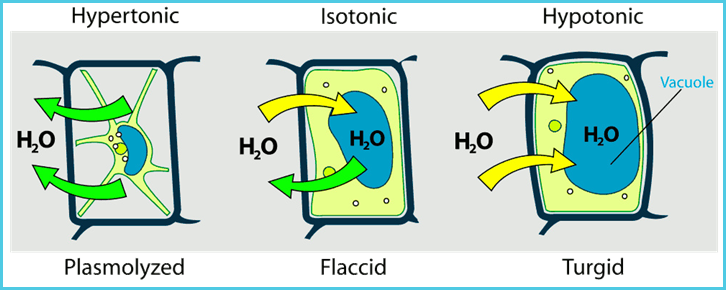
Active Transport
 Active transport is the movement of particles through proteins against the normal
direction of diffusion. In other words, particles are moved from an area of low
concentration to an area of high concentration or “up/against the concentration
gradient”. The cell must use energy to make this happen. This energy comes from
the molecule ATP, which stores
energy in a form that cells can use. An important point of active transport to
remember is that active transport does require energy.
Active transport is the movement of particles through proteins against the normal
direction of diffusion. In other words, particles are moved from an area of low
concentration to an area of high concentration or “up/against the concentration
gradient”. The cell must use energy to make this happen. This energy comes from
the molecule ATP, which stores
energy in a form that cells can use. An important point of active transport to
remember is that active transport does require energy.
Many active transport
processes use carrier proteins to actively move substances through the
membrane. We mentioned carrier proteins already under passive transport. Those
carrier proteins did not require energy to change shape and move substances
across the membrane. These carrier proteins, in active transport, do require
energy to change shape and move substances across the membrane and are called pumps.
One of the most
important active transport carrier proteins in animal cells is the
sodium-potassium pump. The sodium-potassium pump creates an electrochemical
gradient across cell membranes which means the cell membranes, like those of
nerve cells and muscle cells, can carry an impulse throughout the body as in
nerve cells and throughout a muscle contraction as in muscle cells. The
sodium-potassium pump also helps transport glucose and amino acids into the
cell.
Sodium-Potassium Pump
The sodium-potassium
pump actively pumps sodium (Na+) out of the cell while pumping
potassium (K+) into the cell. Three sodium ions from inside the cell
attach to the carrier protein (pump) along with a phosphate from an ATP
molecule. The ATP molecule releases energy in the form of the phosphate which
changes the shape of the pump and releases the three sodium ions outside the
cell. Two potassium ions from the outside
then attach to the pump and are transported into the cell when the pump returns
to its original shape after releasing the phosphate.
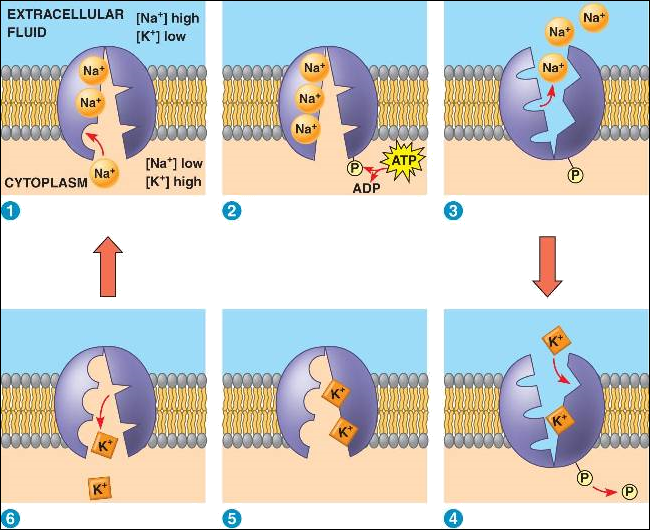
|
Endocytosis and Exocytosis |
|
|
UNIT VOCABULARY
REVIEW

